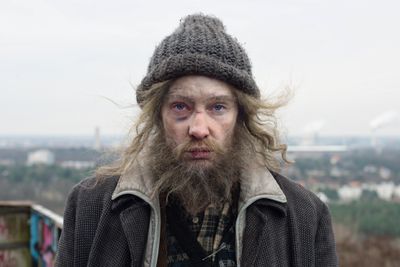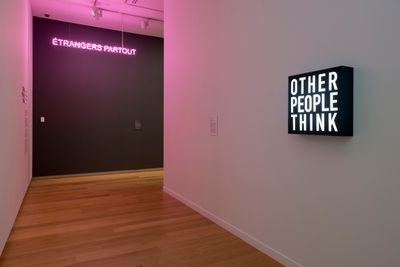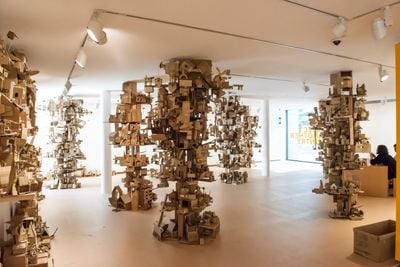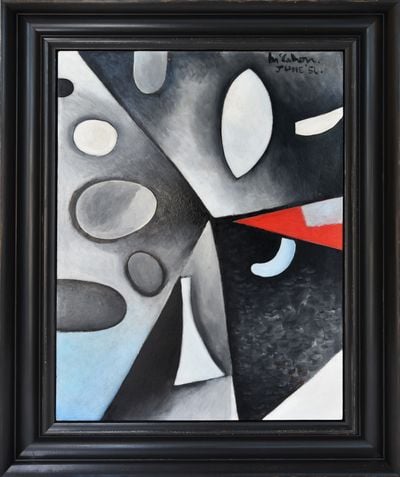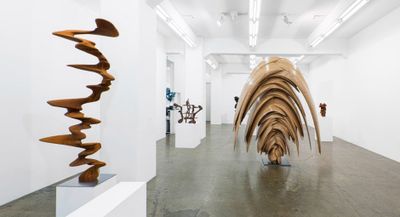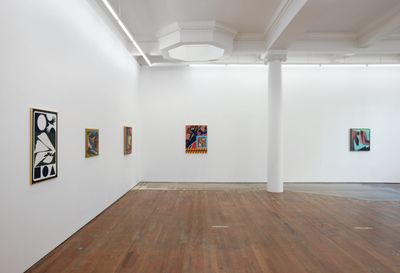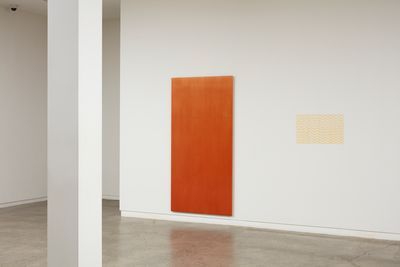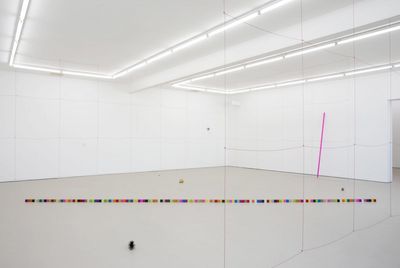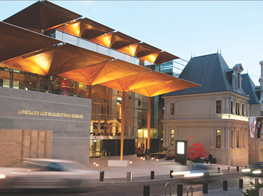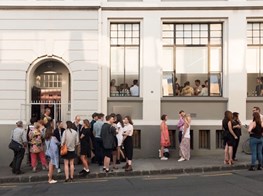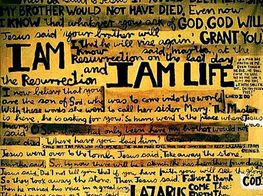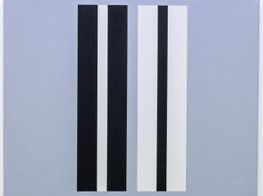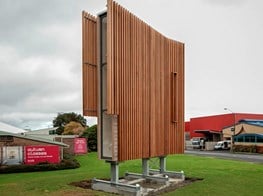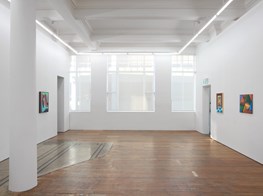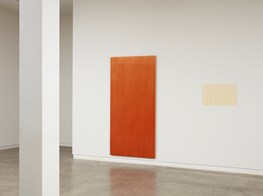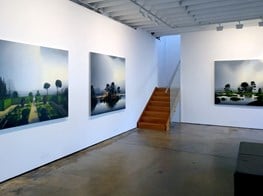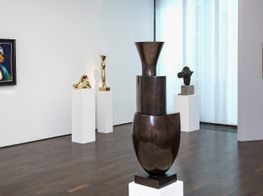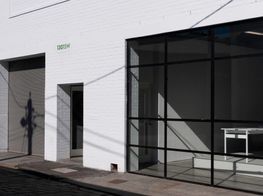Auckland Art Exhibitions: 2018 Lowdown
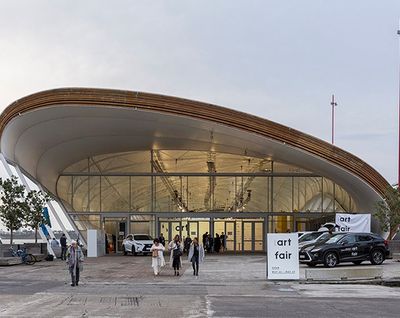
Auckland Art Fair, The Cloud, Queens Wharf. Photo: Jessica Chloe Gernat.
The time is ripe to galvanise New Zealand's public to more fully support its visual arts. With New Zealand-born artists like Simon Denny, Michael Stevenson and Francis Upritchard continuing to gain international acclaim, and a Turner Prize nominee in Luke Willis Thompson, the international art world is beginning to take notice of this small nation's creative clout, but in terms of domestic support, more needs to be done. Art fairs can instigate increased interest in the arts generally, and hopes are running high that Auckland Art Fair (24–27 May 2018), presented in The Cloud on Queens Wharf, will do just that.
This Ocula Lowdown offers a selection of the best contemporary art exhibitions to see in Auckland over the period of the Auckland Art Fair (24-27 May 2018), and beyond.
Auckland Art Gallery Toi o Tāmaki, cnr. Kitchener and Wellesley Street, Central Auckland
In the wake of funding troubles for the city's major art institution (its budget has been cut progressively from NZD 12 million in 2012 to its present NZD 6.9 million), Auckland Art Gallery and its supporters are currently holding their breath to see if the museum will receive the additional NZD 2 million in funding per year that the city's mayor has proposed for the next decade. Certainly, the current exhibitions at the gallery present strong arguments for this increased financial support.
Julian Rosefeldt: Manifesto
24 February–15 July 2018
German-born artist and filmmaker Julian Rosefeldt has described his filmic art installation Manifesto as ultimately aiming to question the role of the artist in society. Starring Cate Blanchett, this stunning immersive 13-screen film installation pays homage to the tradition of artist manifestos. Each screen, playing simultaneously features a film segment of no more than eleven minutes in which Blanchett performs as a different contemporary character while reciting excerpts of manifestos from various political and artistic movements. In one segment, Blanchett portrays a funeral speaker reciting the Dada manifesto; in another, she plays a mother who recites Claes Oldenburg's I Am For An Art (1961) at the family table.
The film's darkened exhibition space is jarring and dislocating upon arrival, which serves to heighten the cinematic drama that Rosefeldt maximises in this monumental work. Seven screens are placed against and around the walls, and the remaining six films are shown on double-sided screens that splice the space. It is impossible to initially focus on one film or view the work in its entirety, and there is a sense of fragmented chaos as sounds bleed between films. While Blanchett's characters and their monologues seem to compete for attention at first, as the senses settle down it does become possible to focus on each film, and from the installation's layering of voices and opinions arises a sense of collaboration across time; with each manifesto challenging accepted notions and allowing new possibilities to take shape.
Other People Think: Auckland's Contemporary International Collection
10 March–10 June 2018
Spread out over three rooms, the gallery's current exhibition features work from its permanent collection and prompts visitors to 'consider alternative perspectives and the potential of contemporary art to foster understanding and empathy in a complex and shifting world.' It takes its title from a light work by Chilean-born artist, architect and filmmaker Alfredo Jaar, who delivered the keynote lecture on the occasion of the gallery's major group exhibition last year, Space to Dream: Recent Art from South America (7 May–18 September 2016). In his lecture, Jaar spoke about the power of the image to change minds and ideas, and his work in the current exhibition—a light-box he completed in 2012, which simply comprises the words 'OTHER PEOPLE THINK' in white neon against black—resides appropriately at the entrance to the exhibition.
By using the title Other People Think, both the gallery and Jarr are also referring to a 1927 essay of the same name by American composer and theorist John Cage. The essay was a striking critique of the United States' relations with Latin America, in which a 15-year-old Cage wrote: 'it is our task to consider Latin American thought and respect it'. Presented in a city with a rapidly changing demographic, the exhibition is intended to reflect on New Zealand's relationship with the Asia Pacific region and South America, and features work by a broad range of international artists, including Japanese-born photographer Hiroshi Sugimoto, Thailand-born Mit Jai Inn, Brazilian-born María Nepomuceno, indigenous Australian artist Emily Kame Kngwarreye, and many more.
Alfredo and Isabel Aquilizan: From Pillars to Posts: Project Another Country
30 April–16 September 2018
Continuing the argument that art matters is From Pillars to Posts: Project Another Country, the most recent interactive artwork by husband-and-wife artistic duo Isabel and Alfredo Aquilizan, commissioned for the gallery's Todd Foundation Creative Learning Centre. The space was previously occupied by Yayoi Kusama's The obliteration room (2002–present), and her proliferating dots have been replaced by a growing collection of small fragile-looking houses created from recycled cardboard boxes. The Aquilizans have invited the Auckland community to collaborate in their project by providing materials for gallery visitors to produce these small cardboard houses, which will be amassed around pillars over the course of the project. The installation is part of the artists' ongoing series of site specific projects that explore ideas surrounding community, family, migration, and most poignantly the question of what defines a home. While the work is related to the artists' own experience of migrating from Manila to Brisbane in 2006, it was initially inspired by the itinerant existence of the marginalised Badjao people, who traditionally occupied the waters and shores of the Sulu Archipelago in southwestern Philippines and the northern shores of Borneo, but who have become increasingly displaced by conflict.
Wi Taepa: Retrospective
28 April–2 September 2018

A city's public art institutions are also crucial for drawing attention to, celebrating and supporting creative home-grown excellence. The gallery's Wi Taepa: Retrospective is dedicated to celebrating the life and work of Māori clay artist Wi Taepa by looking back at over 30 years of his practice. After his military career, which included two years serving in the Vietnam War, Taepa worked initially as a prison officer and then a social worker, teaching wood and bone carving and leather and copper work, using art to facilitate connections and aide rehabilitation. In 1985 he began working with clay, incorporating traditional Māori motifs into his practice, rejecting the wheel and building works by hand, firing them in sawdust. The works are organic; their flaws are a reminder of the hand that creates them.
Taepa references his interest in clay back to the 1960s, when he saw an exhibition of ceramics by the English artist Jo Munro at the Willeston Gallery in Wellington. In 1987, Taepa, alongside four other artists—Baye Riddell, Paerau Corneal, Colleen Waata Urlich and Manos Nathan—formed Ngā Kaihanga Uku, a collective of Māori clay-workers. The group, which came to be known as 'The Tight Five' or 'Ngā Tokorima' adopted three shared principles: first, they would approach working with clay from a Māori perspective; second, they would share their collective knowledge and resources; and third they would engage with indigenous cultures with ceramic traditions. In 2013, an exhibition of works by these five founding members, Uku Rere, was held at Pātaka Art + Museum in Wellington, where the first iteration of the artist's major survey presented at Auckland Art Gallery was shown in 2016.
Kitchener Street, Central Auckland
Colin McCahon
Gow Langsford Gallery
16 May–9 June 2018
Across the road from Auckland Art Gallery is one of New Zealand's most influential dealer galleries, Gow Langsford Gallery, which has staged some 500 exhibitions since it was founded in 1987. The gallery's founders, John Gow and Gary Langsford, were recently named members of the New Zealand Order of Merit for their significant contributions to the growth of contemporary art.
Following up its exceptional solo presentation at Art Basel in Hong Kong of influential New Zealand artist Colin McCahon (1919–1987), the gallery is exhibiting seven of his paintings at its Kitchener Street gallery space. Spanning two decades of the artist's life, the show intends to 'document the scope of the artist's evolving concerns', which the gallery's press release expresses as 'the relationship between Māori and the New Zealand landscape, as well as the influence of early settlers and their beliefs on this revered land.'
One work, Painting (1956) belongs to a small group of compositions that reflect McCahon's exploration of the formal concerns of abstraction, as well as a desire to capture the essence of his surrounding landscape. Rendered in a palette of mostly greys, blacks and off-white, with a hint of blue and section of red, it is one of the earlier works presented in the show, and aside from the artist's recognisable signature in the top right corner, it may surprise those unfamiliar with the full evolution of McCahon's work. While clearly abstract, its composition of shapes that float within clearly delineated spaces emanating from the painting's centre triggers associations with the kauri trees that surrounded the artist's home in Titirangi.
On view at the gallery's other space on Lorne Street is an exhibition dedicated to leading British sculptor Tony Cragg, providing a wonderful opportunity to see the British artist's characteristic organic sculptural forms in a range of materials: from the corten steel Elliptical Column (2016) and the bronze Listeners (2015), to Tempest (2017), which is rendered in stone. Cragg, who is currently a professor at the Kunstakademie Düsseldorf, represented Britain at the 43rd Venice Biennale in 1988 and in the same year was awarded the Turner Prize by Tate Britain.
—
Karangahape Road, Central Auckland
Gordon Walters
Starkwhite
29 May–16 June 2018
Not yet on view, but worth noting in anticipation of its opening, Starkwhite will present an exhibition focused on New Zealand-born modernist legend Gordon Walters. The show is a follow-up to the gallery's presentation of the artist's work at Auckland Art Fair, and a prelude to the major retrospective dedicated to Walter's which opens at Auckland Art Gallery in early July. Organised in partnership with the late artist's estate, the show will focus on Walter's later works, which explore new shapes made by repeated and layered blocks of colour.
Known for his minimal and abstract paintings that incorporate indigenous motifs, two distinctive experiences shaped this Wellington-born painter's output: in 1946, the artist visited painter and photographer Theo Schoon who was then photographing Māori rock art; and in 1950, he moved to Europe where he was inspired by avant-garde painters on the continent such as Piet Mondrian, Auguste Herbin and Victor Vasarely. On his return to New Zealand, Walters subsequently fused these two influences, bringing Māori traditional culture and notions of European abstraction together in hard-edged geometrical works. Using simplified forms, over his five-decade career, Walters gradually evolved his use of the koru—the spiral curving symbol that resembles the curving bulb form of a new fern frond and often appears in traditional Māori carving and tattooing—into the forms that ultimately have come to characterise his signature work. The spiral form began appearing consistently in Walter's work from the late 1950s, and in later works such as the acrylic painting Untitled (1969–1973), which will be showing in Starkwhite's booth at Auckland Art Fair, his organic curves morphed into pure straight lines.
Preceding the exhibition of Walter's works and closing on 26 May, Starkwhite is showing a group exhibition dedicated to many of the stalwarts of its gallery programme, including Martin Basher, Gavin Hipkins, Seung Yul Oh, Fiona Pardington, John Reynolds and others.
Diena Georgetti & Imogen Taylor: Stolen Leopard
Michael Lett
27 April–26 May 2018
Perhaps as an antidote to the masculine modernist aspirations of McCahon and Walters, Michael Lett's current exhibition, Stolen Leopard, brings together the works of two female artists: Diena Georgetti and Imogen Taylor. Georgetti has been exhibiting since the late 1980s, and Imogen Taylor, her younger contemporary, is a 2010 graduate of Elam School of Fine Arts, University of Auckland. Both artists present a new body of paintings in this show, demonstrating a shared reverence, but equally a subtle subversion of the medium and its history.
Georgetti is an Australian-born artist whose career emerged within the context of the artists and curators involved with the influential Melbourne artist-run initiative Store 5, which was established in 1989 by artists Gary Wilson and Kerrie Poliness and operated until 1993. While her acrylic paintings appear to offer up another rendition of abstraction, they in fact hover in the space between abstraction and representation. The artist is unfettered by style, movement or discipline in what she paints. She is a hoarder of sorts, collecting and categorising an archive of imagery gleaned from the web, books and magazines on architecture, art, fashion and design. Her paintings reflect a careful collaging, juxtaposition and layering of this image repository. A work might include references to abstract masters, to a fashion label's motif, or to Japanese prints. Recalling a visit to the artist's studio, City Gallery Wellington curator Robert Leonard noted Georgetti's desire that no reference should ever be too recognisable. She is not paying homage, nor intending her work to represent a form of appropriation; her sources float just off the tip of the tongue.
Like Georgetti, Imogen Taylor dabbles in broad sampling and remixing. In an article for cultural website Noted, Taylor described her paintings as a '"pretty/ugly" mix of Cubism and Regionalism that somehow blends geometric forms with bodily functions'. Taylor appears to be referring to a New Zealand style of regionalism that is characterised by a preoccupation with place and local identity—something she might have reflected on when she lived in the house adjacent to Colin McCahon's home in Titirangi, as part of the prestigious McCahon House Artists' Residency in 2017. The stack of green organic forms and interconnected geometrical shapes infiltrated by a slopping curve in Satan Creeps (2018), appear to be a nod to McCahon and the New Zealand landscape while the painting's title offers a suggestive sneer.
Putiki Street, Grey Lynn
Simon Morris: I watch the falling light
Two Rooms
27 April–26 May 2017
In addition to showing Jan van der Ploeg's vibrant biomorphic abstractions in its upstairs space, Two Rooms is exhibiting, until 26 May, I watch the falling light, a solo exhibition of Simon Morris' latest 'single action paintings'.
In 2016, Simon Morris was elected the eighth recipient of the prestigious annual Fulbright-Wallace Arts Trust Award, which is awarded annually to an outstanding mid-career or senior New Zealand visual artist. As recipient of the Award, Morris was granted a residency at Headlands Center for the Arts in Sausalito, California, and his latest body of work follows on from the time he spent there.
With a palette of burnt oranges, cool yellows and dusty ochres, the exhibition showcases four monochromatic rectangular acrylic paintings on plywood, which are hung vertically on each wall of the gallery space. It also includes four horizontal grid patterns each painted in acrylic wash directly on one of the walls of the gallery.
Often using self-imposed restraints, Morris' practice references conceptual abstraction. The vertical pieces were created by Morris pouring a volume of acrylic paint directly over a flat plywood panel, which he then swung upright in a single motion to drip dry vertically. A close inspection of Falling Light (pale naples) (2018) shows how the transparent and glossy acrylic glazes of yellows he has applied have settled into woodgrains.
Phillip Lai, Peter Robinson: Spinning
Hopkinson Mossman
19 May–23 Jun 2018
Having just closed an exceptional show by the young artist Oscar Enberg and still reeling from the Turner Prize nomination of gallery artist Luke Willis Thompson, Hopkinson Mossman is now showing Spinning, a two-person exhibition of work by Malaysian-born Phillip Lai and New Zealand-born Peter Robinson, both no strangers to art world accolades. Not yet installed at the time of writing this report, the show promises to be an interesting presentation of two well respected artists sharing some of the same artistic concerns.
Phillip Lai recently received a prestigious nomination; he along with Michael Dean, Mona Hatoum, Magali Reus and Cerith Wyn Evans have just been short listed for the Hepworth Sculpture Award, the winner of which will be announced in November 2018. A lecturer at Goldsmiths University of London since 2006, Lai's diverse practice is mostly characterised by his appropriation of readymade everyday objects into spatial assemblages. His exhibitions in the past have explored ideas surrounding the value of objects, the experience of communities and the medium of space. An exhibition at Edouard Malingue Gallery in Hong Kong, In the Half Life (26 March–12 May 2018), included sculptures featuring buckets stacked and placed upon, and in some instances within, custom-made shelves. Lai appears to demand a re-thinking of the ordinariness of the object, querying its making, and prompting a consideration of how and why we perceive the object as we do.
Peter Robinson, who in 2016 was recognised with a Laureate award by the Arts Foundation of New Zealand, started his career as a painter, but now, like Lai, increasingly works with both found and made objects to create sculpture. His early career saw him play a large part in bi-cultural debate, exploring issues around race and identity with works such as Painting (1993), part of the Auckland Art Gallery's collection. The work presents in tar, wax, earth and oil numerous simplified renditions of waka (canoe), each accompanied by numerals that relate to the percentage by which Robinson's genealogy is considered Māori.
Continually evolving in his practice, Robinson's current body of work, most recently on show at Centre of Contemporary Art in Christchurch (CoCA), recalls associations with both post minimalism and also Arte Povera. Entitled Fieldwork, the exhibition at CoCA, which runs until 29 May 2018, includes delicate arrangements of pins, staples, nails, magnets and welding rods—objects commonly found in the artist's studio. A call to action in the institution's press release, invites the viewer to 'move mindfully amongst the work, to discover unexpected perspectives and new paths through and around ... the works carefully placed on floor, walls and ceiling'.
Wynyard Quarter, Downtown Auckland
Acts of Passage
Te Tuhi, Silo 6
18 May–27 May 2018
Contemporary art space Te Tuhi's offsite performance exhibition, Acts of Passage, at Silo Park explores manifestations of performance art from Africa, Aotearoa, Brazil, the Pacific, and Peru, offering what the organisers describe as 'a particularly southern cartography through the practices of artists Albert Ashton, FAFSWAG, Ayrson Heráclito, Kitso Lynn Lelliott, Antonio Paucar, and Rosanna Raymond. The exhibition combines immersive video installations—including Ayrson Heráclito's two-channel video O Sacudimento da Casa de Torre and O Sacudimento da Maison des Esclaves em Gorée (2015), which seeks to decolonise two monuments linked to the Atlantic slave trade using gestures from the Afro-Brazilian exorcism ritual of shaking—with a live performance schedule.
Opened with Albert Ashton performing Te Hikoi, a spiritual walk through the Silos in the Wynyard Quarter to cleanse the site and acknowledge ancestors, the performances in the exhibition explore the theme of ritual as an act of intimate catharsis in a variety of ways. Antonio Paucar's Memories from inside takes ritual practices from the Andes as a point of departure from which to create a situation where sense and poetics are heightened in an experience that commences once the audience has been blindfolded. Subordinate Tissue, a new performance presented by the Auckland-based FAFSWAG, which draws on the collective's celebration of queer Pacific Islander culture by dismantling the hierarchies imposed by the classifications of 'feminine' and 'masculine'. Meanwhile, founder of the SaVAge K'lub and member of the arts collective Pacific Sisters, Rosanna Raymond is staging Ia TuKu around her installation in the exhibition, Fa'amu'umu'umamatane aka Tropic Thunder. Both refer to the United States military presence in the Pacific, with the installation including specially customised military jackets for what the artist has described as 'Ae Kai acti.VA.tion'. Of Samoan descent, the artist focuses on shedding colonial adornments in order 'to reclaim', to borrow the artist's statement, 'her own mana and sovereignty'. —[O]

